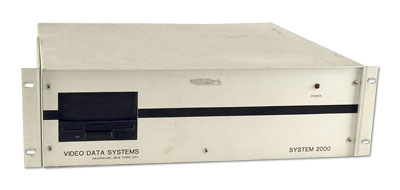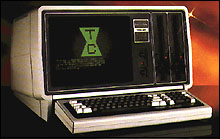WordStar - 1984
At age 15, I got my first high-tech job at a small company called Video Data Systems in Hauppauge Long Island New York. The founder of VDS was Bill Leventer. There I wrote 6800 and 6809 assembly language code for video titling systems on a Motorola Exorciser development system. The code was pretty sophisticated- I wrote an multi-tasking operating system for 6809. The Exorciser had a line editor called 'E', an assembler called 'RASM' and two 8 in. floppy drives. I remember that it took half an hour to link 16K of code and that we always printed the assembly language lists on an old GE chain printer.
One program I wrote was the screen editor for the CG-2000 character generator. This was ridiculously simple- it had fixed width lines stored in a big array. But it did have formatting- specifically, you could set fonts, colors and heights of lines.

Here is the Motorola Exorcizer it was developed on. Remember: type MAID, followed by E800;G to boot MDOS.
At some point, we upgraded to an IBM PC XT and switched to the AD2500 6809 assembler and used WordStar in "non-document mode" for the editor. I remember being annoyed with WordStar because it did not remember the column position when you moved the cursor between lines. On the other hand, I thought the interruptible screen update algorithm was pretty cool- it was certainly a total necessity on the 4.77 MHz 8088 based system. I also learned C on the IBM PC, using Microsoft's MS-DOS C compiler.
There is a nice history of WordStar here.
I had gotten pretty familiar with many of the microcomputers available in this time period, including: Commodore-64 (I wrote a remote terminal for VDS for this, in half BASIC half 6502 assembly language), Atari-800 (it had a real OS, unlike the C-64) and Radio Shack model 16. My mom used the Radio Shack model 16 for her home business: it had an 8 MB hard drive and ran RM/COS (to run RealWorld accounting) or TRS-DOS (it could run UNIX as well, but we didn't have it). There was some assembly language editor that I don't remember which ran on either RM/COS or TRS-DOS which moved the cursor the same way that JOE does- it kept the column constant, even when moving from a long line to a short line, and without actually adding any text to the file.

The DecSystem 20 - 1986
In 1986 I went to college at Worcester Polytechnic Institute, majoring in electrical engineering. WPI was one of the great hacker schools, with many students writing programs both before and during my time there. WPI had a Decsystem-20 mainframe computer which ran TOPS-20. This was a famous 36-bit computer, especially in the LISP world, because each word could hold two 18-bit addresses and was therefore perfect for a LISP CONS cell. It had an awesome mail program, which was both mail and USENET news in one program. The shell had ESC-completion and question-mark help (if you hit ? at the end of syntactically correct command, it said "(confirm)"). It had EDT, TECO, EMACS written in TECO, and a bunch of other editors, many of them student written. Despite all that, I tended to write in macro using a line editor. I tried the C compiler, but it was really weird- it used 9-bit bytes! Mind you, characters were normally 7-bits on this machine, with 5 characters packed into a 36-bit word. I remember that the operating system manual which was written by someone at Stanford (who?) was always missing from the library- borrowed months at a time by hackers.
This page gives you a good feel for what the DEC-20 was like.
The Encore Multimax - 1988
In 1988 WPI replaced the DEC-20 with an Encore Multimax which ran a version of UNIX called Umax. Originally, the system lacked USENET, so a friend of mine, Larry Foard, wrote a local BBS system for it called bboard. Bboard had a terrible line editor, so I wrote a screen editor called 'e' for writing BBS messages. This is really the first version of JOE. Other hackers wrote 's'- an instant messaging program, and 'superwho'- a program which drew a map show which terminal each student was logged in on.
Here is some history of Encore. The company's "Annex" terminal servers had longer history than its computers.
Larry Foard went on to write TinyMush.
Why not emacs or vi? I couldn't stand emacs- it was always saying "garbage collecting... done.", used awkward weird keys, formatted my source code the wrong way and basically just had an arrogant attitude. It was especially frustrating that Ctrl-H was not backspace. I was certainly too impatient to conform to it when I could just write my own editor.
JOE might never have been had I understood how nice vi was at the time. Luckily, the commands were not documented in the 'man' page and both it and the UNIX line editors 'ex' and 'ed' did not work like the line editors I was familiar with. Specifically, I thought it was stupid that these editor did not allow you to position the cursor past the ends of lines (or files), forcing you to use the append command instead of the insert command for these cases.
e - 1988
I wrote 'e' before I knew about the gap buffer data structure, but the method I came up with was pretty close: the file is stored in a large array. A small array (maybe 1K bytes) has a copy of a small part of the larger array. Most edits occurred in the small array to keep the insert/delete cost low. When an edit is requested outside of the range of what is in the small array, it is swapped into the large array and new part of large array (centered around the cursor) is copied into the small array.
'e' was released to the general public in the USENET newsgroup alt.sources in 1989 or 1990 (I don't remember which year, and Google's alt.sources records are spotty for this period). An announcement was posted to comp.editors. This version of JOE had an interruptible screen update algorithm and worked pretty well over my 1200 baud modem. Only VT100 and VT52 terminals are supported.
j
People complained that 'e' was a synonym for vi, so I re-named the editor 'j' and released it on alt.sources again. Somewhere around this time, I replaced my buffer data structure with a gap buffer. My gap buffer code appeared in a Dr. Dobbs Journal article [find reference].
joe0.0.0
'j' turned out to be the name of a programming language, so someone (either on alt.sources or comp.editors) suggested I call the editor JOE, for Joe's Own Editor.
joe1.0
I rewrote the editor: now the data structure is a linked-list of gap buffers which can be swapped to a file, so that the maximum file size is not limited by the amount of virtual memory. Also, the key-binding code was created which allowed for the joerc file. Also, this version of JOE supports any terminal type with /etc/termcap support.
A lot of this work took place while I was living on the top floor of the 5 story "Griggs" building on Pleasant st., Worcester. This was a bad area of Worcester MA, but we learned that thieves are lazy: the first floor got robbed all the time, but nobody would bother climbing 4 flights of stairs, so we could basically leave the door unlocked. There were 7 people and 7 cats living together. My share of the rent was about $130 a month. I inherited two of the cats: Puck and Zack.
joe2.0
joe2.2
This version is ported to MS-DOS.
joe2.8
Last version from me until Joe 3.0. In the intervening 9 years, I got married, had two kids, got a real full time job, and bought a house. Others patched this version, fixing minor bugs and security holes.
joe2.9
Marec Grac and Vitezslav Samel put JOE on SourceForge. They reformat the code to the same standard as the Linux kernel, put it under source control and switch to the standard 'configure' script.
joe3.0 - April 2004
I start working on the editor again. I start by adding syntax highlighting to the editor- this has been the most requested feature since JOE 2.8. Also I add UTF-8 support, with much guidance from Egmont Koblinger (who is Hungarian).
Here is the source to some very old versions of JOE, including 'E' and 'J'.